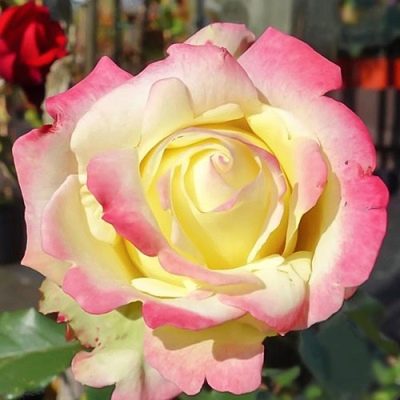
- Authors: W. Kordes' Söhne
- Name synonyms: Athena, Athena
- Breeding year: 2014
- Group: tea-hybrid
- The main color of the flower: white
- Flower shape: classic
- Flower size: large
- Diameter, cm: 11-12
- Flower type by number of petals: thick double
- Scent: fresh
Among the many pink varieties, there are varieties that are highly popular among landscape designers and florists, as they amaze with their visual appeal, abundance of flowering and ease of cultivation. One of these is the Atena variety, which has become incredibly popular over the past few years.
Breeding history
Rose Atena, representing a group of hybrid tea varieties, was bred by a group of German breeders W. Kordes` Sohne in 2014. The authorship belongs to Herman Cordes. Due to its quick adaptation to climatic features, the rose can be grown in almost any region of Russia, Ukraine, Belarus.
Description of the variety
The German rose Atena, part of the Eleganza collection, is a vigorous shrub with erect shoots. The bush grows up to 100-125 cm in height. The plant has medium foliage with large dark green leaves with a matte surface, powerful stems with rare sharp spines, as well as a developed rhizome that lies deep in the ground. 3-5 flowers are formed on each stem. The rose bush looks compact, airy and voluminous, about 100 cm in diameter.
Advantages and disadvantages
The flower bush is endowed with many advantages: frost resistance, good heat tolerance, abundant and long flowering, high immunity, preventing diseases, ease of growing and care. Among the disadvantages, many growers point to the average tolerance of prolonged rains, in which the petals tend to stick together.
Flowering features
Rose Atena blooms from June to September. The variety belongs to the re-flowering varieties. Flowers are formed both singly and in small inflorescences. Elegant buds open very slowly, which allows you to enjoy the beautiful flower for a long time. In structure, the rose is densely double, consisting of 40-45 petals. The size of the rose is large, the diameter is up to 11-12 cm. The color of the rose is unusual, two-tone: the snow-white base is complemented by a pink border. The fully blossoming flower emits an intense refreshing aroma with sweetish notes.
Use in landscape design
Gourmet roses are grown in flower beds, used for zoning front gardens, and group flower arrangements are made with them. It is also suitable for growing cut flowers. Cut Atena roses retain their freshness for a long time when placed in a vase of water.
Landing
For planting a German rose, it is recommended to choose sunny places where there is a lot of light and warmth during the day, because the petals do not get burns, even if they are under the scorching sun all day. It is important that the site is protected from drafts and cold gusty winds.
The bushes are planted in loose and fertilized soils with good moisture and air permeability. In addition, you should pay attention to the level of soil acidity (the norm is 5.7-7.3 pH). It is not recommended to plant rose bushes in lowlands where cold air and moisture accumulate.
The rose is planted from March to May, and autumn plantings are also allowed from late August to October (southern regions). Pits 50-60 cm deep are prepared on the site, where light gravel drainage and a layer of fertilizers are placed, and then the seedling is planted.At the end of planting, abundant watering with warm water is performed, gently ramming the soil. It is recommended to plant no more than 4-5 seedlings per 1 m2.
Growing and care
Plant care consists of watering, loosening and weeding the soil, fertilizing, sanitary pruning, shelter for the winter and disease prevention.
Watering and feeding
The rose needs good hydration. Water the bush once a week, but with a strong and prolonged drought, you can double the amount of watering. Water is introduced at the root.
Fertilizers are applied twice a season: in spring and in mid-summer. In the spring, the plant needs nitrogen-containing fertilizers, and in the summer, phosphorus-potassium fertilizers.
Pruning
A rose bush needs two full pruning pruning. In early spring, frozen shoots are removed, and they are also well shortened. In the fall, pruning of damaged and dried branches is carried out. During active flowering, you need to pluck wilted buds.
Frost resistance and preparation for winter
Despite their frost resistance, rose bushes need shelter for the winter. A strong frame is erected over the cut bushes, on which a film or agrofibre is stretched. In early spring, the shelter is removed. This design is suitable for regions with severe and little snowy winters. For warmer regions, high-quality mulching using sawdust or spruce branches is suitable.
Diseases and pests
The plant has good immunity, providing medium resistance to a number of diseases, for example, powdery mildew and black spot. Pests rarely attack pink plantings.































































